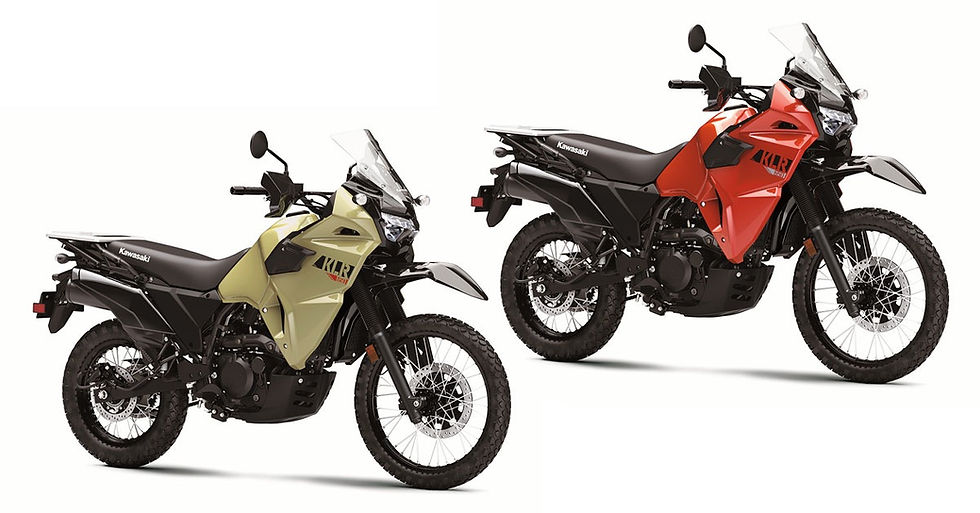Suzuki Announces Reinvigorated New Hayabusa For 2021
- Mathieu Day-Gillett

- Feb 5, 2021
- 4 min read
Updated: Feb 9, 2021

It’s arguably one of the first true hyperbikes and now Suzuki has pulled the covers off the third generation of the legendary GSX1300RR Hayabusa, which is expected to arrive in New Zealand mid-year.
Now, if you were expecting Suzuki’s supreme sportsbike to enter its third generation with the aid of forced induction to boost power even further, well, you’ll be a little disappointed. In fact, the new Hayabusa has actually dropped power from the near 200hp(145kw) of the second generation to 190hp (140kw) for the new model. But that’s not a bad thing.
Instead of reinventing the wheel, Suzuki has opted for the safe approach and given the Japanese firm’s hero a thorough makeover to bring it in line with global emissions as well as add plenty of useful tech. The result is a bike that is actually quicker to 100kph than the last generation by 0.2 seconds and quicker to 200mph by 0.1 seconds.

Not only has the engine received a heap of refinements including optimised exhaust, redesigned SRAD intake system, new cams hand revised engine internals for better durability plus a ride by wire throttle (and more), the Hayabusa has also been brought up to date with a new electronics suite based around a Bosch six-axis IMU.
Thanks to the IMU and ride-by-wire throttle, the new Hayabusa is able to utilise an advanced new version of the Suzuki Intelligent Ride System (S.I.R.S.), which gives the bike a host of electronic controls to optimise performance characteristics to match the needs of the moment and make the Hayabusa more controllable and predictable.
Riders can opt for pre-set settings that best suit riding conditions and varying road surfaces, as well as their level of confidence and experience.
Included in the Hayabusa’s S.I.R.S system are three power modes, traction control, anti-lift control, engine braking control and a bi-directional quick shifter. For those who live to take their bike to the drag strip, Suzuki has also included launch control in the electronics package as well while touring riders will benefit from the built-in cruise control system.

Suzuki says the new Hayabusa was developed not only to achieve an even higher overall balance performance and comply with the stringent Euro 5 emissions standards, but also to “capture the hearts of both devoted followers and all who lay eyes on the stunning beauty and sharper, tauter form of its bold new design.”
That means that not only has the bike had a refresh of the engine but it’s overall aesthetic as well. Visually the bike has sharper lines to give the bike a more modern appeal all while Suzuki’s engineers managed to maintain the bike‘s already stellar aerodynamics.
Lighting is now provided by a new set of LEDs, while the air intake for the SRAD system has been redesigned along with the bodywork of the bike.

One visual element Suzuki tried to keep very familiar while simultaneously giving it a big hit with the new technology stick was the Hayabusa’s dash cluster. The large analogue tachometer and speedometer gain a fresh visual design with bigger, bolder numbering that improves readability. Raised scale markings around the periphery of each meter use LED lighting to provide a clearer view and faster recognition, both at midday and at night. Carrying the theme of gold-coloured accents throughout the cockpit area, the analogue fuel and coolant temperature gauges that flank the meters are ringed in gold, as are the SDMS and Active Data display screens on the TFT LCD panel.
One standout new feature is the TFT LCD panel mounted in the centre, between the two main meters. It displays either the current SDMS-α systems settings or an Active Data display that shows lean angle (with peak-hold function), front and rear brake pressure, rate of forward/reverse acceleration, and the current accelerator position. The panel also shows clock, gear position, odometer, dual trip meter, ambient temperature, instantaneous fuel consumption, riding range, trip time, average fuel consumption, and voltmeter displays.
An additional feature of the TFT panel is a brief animation of the Hayabusa kanji character that plays when the ignition key is turned on. A second animation featuring the Suzuki logo plays before the display is turned off.

Continuing the control theme, Suzuki also refined the chassis of the new Hayabusa. The frame itself is 700grams lighter than the second generation bike while the suspension settings have been further developed.
Up front is an updated version of the Hayabusa’s fully adjustable KYB inverted forks with 43mm outer diameter DLC-coated inner tubes. The internal structure has been revised to further improve the forks’ ability to absorb the road surface and ensure a smoother, more stable ride with optimum grip. In a similar fashion, the internal structure of the fully adjustable KYB rear shock absorber was also revised to help optimize comfort and straight-line stability.
The Hayabusa also sees its brakes upgraded, now rocking Brembo’s latest Stylema front brake calipers. Suzuki says these new calipers increase airflow around the brake pads to cool more quickly and deliver immediate braking response, while the diameter of the front discs is increased from 310mm to 320mm and a new hole pattern adopted to further help optimize cooling efficiency.
The new Hayabusa will also launch with a full range of accessories including bike-specific luggage.
As for when we can expect the bike to arrive and how much Kiwis will need to fork out for the new Hayabusa, at the time of writing Suzuki NZ is yet to make an official announcement. We’ll keep you in the loop for when we get the official word.




